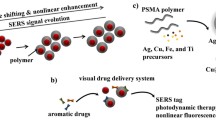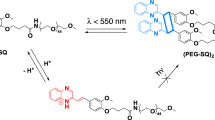Abstract
We propose the photopolymerization of lipoic acid (LA) as an novel approach to produce a cross-linked polymeric matrix of lipoic acid monomers (PALA) which helps to control the size of plasmonic gold nanostructures when using 3,3,6,8-tetramethyl-1-tetralone as the photo-initiator for the reduction of Au(III) to Au0. A complete characterization of the polymer is included, and the dual behaviour of LA as an in situ stabilizer and reducing agent is investigated. These findings are relevant to the understanding of the photochemical transformation of this biologically relevant compound and would benefit the increasing use of LA and PALA for the synthesis of various nanomaterials.
Graphical abstract









Similar content being viewed by others
Data availability
The datasets generated during and/or analysed during the current study are available from the corresponding author on reasonable request.
References
Scott, B. C., Aruoma, O. I., Evans, P. J., O’Neill, C., Van Der Vliet, A., Cross, C. E., Tritschler, H., & Halliwell, B. (1994). Lipoic and dihydrolipoic acids as antioxidants. A critical evaluation. Free Radical Research, 20, 119–133.
Moini, H., Packer, L., & Saris, N. E. L. (2002). Antioxidant and prooxidant activities of α-lipoic acid and dihydrolipoic acid. Toxicology and Applied Pharmacology, 182, 84–90.
Packer, L., & Cadenas, E. (2011). Lipoic acid: Energy metabolism and redox regulation of transcription and cell signalling. Journal of Clinical Biochemistry Nutrition, 48, 26–32.
Salehi, B., Berkay Yılmaz, Y., Antika, G., BoyunegmezTumer, T., FawziMahomoodally, M., Lobine, D., Akram, M., Riaz, M., Capanoglu, E., Sharopov, F., Martins, N., Cho, W. C., & Sharifi-Rad, J. (2019). Insights on the use of α-lipoic acid for therapeutic purposes. Biomolecules, 9, 356.
Kim, K., Kim, J., Kim, H., & Sung, G. Y. (2021). Effect of α-lipoic acid on the development of human skin equivalents using a pumpless skin-on-a-chip model. International Journal of Molecular Sciences, 22, 2160.
Podda, M., Rallis, M., Traber, M. G., Packer, L., & Maibachl, H. (1996). Kinetic study of cutaneous and subcutaneous distribution following topical application of [7,8–14C] rac-α-lipoic acid onto hairless mice. Biochemical Pharmacology, 52, 627–633.
Devasagayam, T. P. A., Subramanian, M., Pradhan, D. S., & Sies, H. (1993). Prevention of singlet oxygen–induced DNA damage by lipoate. Chemico-Biological Interactions, 86, 79–92.
Suzuki, Y. J., Tsuchiya, M., & Packer, L. (1991). Thioctic acid and dihydrolipoic acid are novel antioxidants which interact with reactive oxygen species. Free Radical Research Communications, 15, 255–263.
Häkkinen, H. (2012). The gold-sulfur interface at the nanoscale. Nature Chemistry, 4, 443–455.
Asadirad, A. M., Erno, Z., & Branda, N. R. (2013). Photothermal release of singlet oxygen from gold nanoparticles. Chemical Communications, 49, 5639–5641.
Bard, A., Rondon, R., Marquez, D. T., Lanterna, A. E., & Scaiano, J. C. (2018). How fast can thiols bind to the gold nanoparticle surface? Photochemistry and Photobiology, 94, 1109–1115.
Matsugo, S., Han, D., Tritschler, H. J., & Packer, L. (1996). Decomposition of alpha-lipoic acid derivatives by photoirradiation-formation of dihydrolipoic acid from alpha-lipoic acid. Biochemistry and Molecular Biology International, 38, 51–59.
Wagner, A. F., Walton, E., Boxer, G. E., Pruss, M. P., Holly, F. W., & Folkers, K. (1956). Properties and derivatives of α-lipoic acid. Journal of the American Chemical Society, 78, 5079–5081.
Affleck, J. G., & Dougherty, G. (1950). The preparation and relative recativities of many-membered cyclic disulfides. Journal of Organic Chemistry, 15, 865–868.
Brown, P. R., & Edwards, J. O. (1969). Effect of solvent on the photolysis of.alpha.-lipoic acid. Journal of Organic Chemistry, 34, 3131–3135.
Brown, P. R., & Edwards, J. O. (1969). Use of thin-layer chromatography in following product formation in the photolysis of alpha-lipoic acid. Journal of Chromatography, 43, 515–518.
Bradley, D. F., & Calvin, M. (1955). The effect of thioctic acid on the quantum efficiency of the Hill reaction in intermittent light. Proceedings of the National Academy of Sciences of the United States of America, 41, 563–571.
Barltrop, J. A., Hayes, P. M., & Calvin, M. (1954). The chemistry of 1,2-dithiolane (trimethylene disulfide) as a model for the primary quantum conversion act in photosynthesis. Journal of the American Chemical Society, 76, 4348–4367.
Bucher, G., Lu, C., & Sander, W. (2005). The photochemistry of lipoic acid: Photoionization and observation of a triplet excited state of a disulfide. ChemPhysChem, 6, 2607–2618.
Simoncelli, S., de AlwisWeerasekera, H., Fasciani, C., Boddy, C. N., Aramendia, P. F., Alarcon, E. I., & Scaiano, J. C. (2015). Thermoplasmonic ssDNA dynamic release from gold nanoparticles examined with advanced fluorescence microscopy. The Journal of Physical Chemistry Letters, 6, 1499–1503.
Cely-Pinto, M., & Scaiano, J. C. (2021). Photoenolization as a convenient driver for the synthesis of plasmonic nanostructures. Photochemical & Photobiological Sciences, 20, 1611–1619.
Li, C.-C., Chang, S.-J., Su, F.-J., Lin, S.-W., & Chou, Y.-C. (2013). Effects of capping agents on the dispersion of silver nanoparticles. Colloids and Surfaces A: Physicochemical Engineering Aspects, 419, 209–215.
Restrepo, C. V., & Villa, C. C. (2021). Synthesis of silver nanoparticles, influence of capping agents, and dependence on size and shape: A review. Environmental Nanotechnology Monitoring & Management, 15, 100428.
Javed, R., Zia, M., Naz, S., Aisida, S. O., Ain, Nu., & Ao, Q. (2020). Role of capping agents in the application of nanoparticles in biomedicine and environmental remediation: Recent trends and future prospects. Journal of Nanobiotechnology, 18, 172.
Gao, M., Sun, L., Wang, Z., & Zhao, Y. (2013). Controlled synthesis of Ag nanoparticles with different morphologies and their antibacterial properties. Materials Science and Engineering: C, 33, 397–404.
Hussain, I., Brust, M., Papworth, A. J., & Cooper, A. I. (2003). Preparation of acrylate-stabilized gold and silver hydrosols and gold−polymer composite films. Langmuir, 19, 4831–4835.
Shimmin, R. G., Schoch, A. B., & Braun, P. V. (2004). Polymer size and concentration effects on the size of gold nanoparticles capped by polymeric thiols. Langmuir, 20, 5613–5620.
Alli, A., Hazer, B., & Baysal, B. M. (2006). Determination of solubility parameters of cross-linked macromonomeric initiators based on polypropylene glycol. European Polymer Journal, 42, 3024–3031.
Arima, T., Hamada, T., & McCabe, J. F. (1995). The effects of cross-linking agents on some properties of HEMA-based resins. Journal of Dental Research, 74, 1597–1601.
Liu, Z., Shen, N., Tang, Z., Zhang, D., Ma, L., Yang, C., & Chen, X. (2019). An eximious and affordable GSH stimulus-responsive poly(α-lipoic acid) nanocarrier bonding combretastatin A4 for tumor therapy. Biomaterials Science, 7, 2803–2811.
Kisanuki, A., Kimpara, Y., Oikado, Y., Kado, N., Matsumoto, M., & Endo, K. (2010). 19. Kisanuki_10. Journal of Polymer Science, 48, 5247–5253.
Wada, N., Wakami, H., Konishi, T., & Matsugo, S. (2009). The degradation and regeneration of α-lipoic acid under the irradiation of UV light in the existence of homocysteine. Journal of Clinical Biochemistry Nutrition, 44, 218–222.
Endo, K., & Yamanaka, T. (2006). Copolymerization of lipoic acid with 1,2-dithiane and characterization of the copolymer as an interlocked cyclic polymer. Macromolecules, 39, 4038–4043.
Niu, Z., & Gibson, H. W. (2009). Polycatenanes. Chemical Reviews, 109, 6024–6046.
Endo, K., Shiroi, T., & Murata, N. (2005). Thermal polymerization of 1,2-dithiane. Polymer Journal, 37, 512–516.
Clarson, S. J., & Semlyen, J. A. (1986). Studies of cyclic and linear poly(dimethyl-siloxanes): 21. High temperature thermal behaviour. Polymer, 27, 91–95.
Xue, Y., Li, X., Li, H., & Zhang, W. (2014). Quantifying thiol–gold interactions towards the efficient strength control. Nature Communications, 5, 4348.
Trzciński, J. W., Morillas-Becerril, L., Scarpa, S., Tannorella, M., Muraca, F., Rastrelli, F., Castellani, C., Fedrigo, M., Angelini, A., Tavano, R., Papini, E., & Mancin, F. (2021). Poly(lipoic acid)-based nanoparticles as self-organized, biocompatible, and corona-free nanovectors. Biomacromolecules, 22, 467–480.
Dzwonek, M., Załubiniak, D., Piątek, P., Cichowicz, G., Męczynska-Wielgosz, S., Stępkowski, T., Kruszewski, M., Więckowska, A., & Bilewicz, R. (2018). Towards potent but less toxic nanopharmaceuticals – lipoic acid bioconjugates of ultrasmall gold nanoparticles with an anticancer drug and addressing unit. RSC Advances, 8, 14947–14957.
Acknowledgements
This work was supported by the Natural Sciences and Engineering Research Council, the Canada Foundation for Innovation and the Canada Research Chairs program.
Author information
Authors and Affiliations
Corresponding author
Ethics declarations
Conflict of interest
There are no conflicts to declare.
Supplementary Information
Below is the link to the electronic supplementary material.
Rights and permissions
Springer Nature or its licensor (e.g. a society or other partner) holds exclusive rights to this article under a publishing agreement with the author(s) or other rightsholder(s); author self-archiving of the accepted manuscript version of this article is solely governed by the terms of such publishing agreement and applicable law.
About this article
Cite this article
Cely-Pinto, M., Wang, B. & Scaiano, J.C. Understanding α-lipoic acid photochemistry helps to control the synthesis of plasmonic gold nanostructures. Photochem Photobiol Sci 22, 1299–1307 (2023). https://doi.org/10.1007/s43630-023-00378-5
Received:
Accepted:
Published:
Issue Date:
DOI: https://doi.org/10.1007/s43630-023-00378-5




